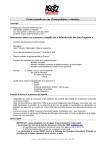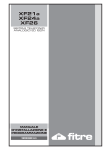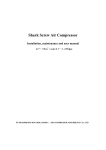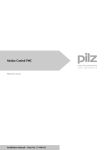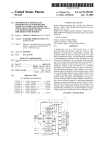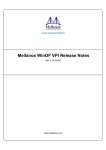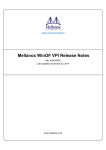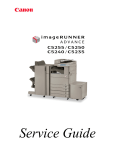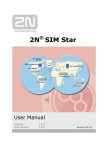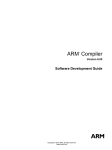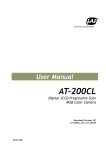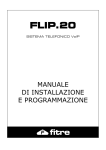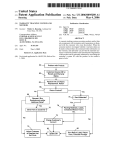Download Method and system for assisting users with operating network devices
Transcript
US 20130036108A1
(19) United States
(12) Patent Application Publication (10) Pub. N0.: US 2013/0036108 A1
Corbeau
(54)
(43) Pub. Date:
METHOD AND SYSTEM FOR ASSISTING
USERS WITH OPERATING NETWORK
DEVICES
(52)
(57)
(76)
Inventor;
Maxime Corbeaus Den Haag (NL)
(21)
AP p1 NO _ 13/196 807
Feb. 7, 2013
US. Cl. ............... .. 707/722; 707/769; 707/E17.014
'
ABSTRAOT
A method mcludes steps of: receiving data from a network by
a web browser executed by a computer connected to the
network, analyzing the data received for determining if the
.
(22) Filed:
..
,
Aug. 2, 2011
Publication Classi?cation
(51)
Int. Cl.
G06F 17/30
(2006.01)
data received is transmitted by a network device, extracting
keywords from the data transmitted by a network device,
generating a query from the keywords extracted from the data
received, sending the query through the network to a web
interface of a support database providing support information
about operating the network device, receiving from the net
work query results transmitted by the support database, and
displaying the query results with the page transmitted by the
network device.
Patent Application Publication
Feb. 7, 2013 Sheet 1 0f 9
US 2013/0036108 A1
E5 {Ia-aim 211E529
E6
Search click E
E7
E1
E8
Tab closed E
E9
FIG- 3
E10
Patent Application Publication
Feb. 7, 2013 Sheet 2 0f 9
US 2013/0036108 A1
APRF ID
511
/512
Notlfy
p' E VTM
I
v
( End ><N
Cont?
Y
H
S516
N
WIN/Tab ID V3
\’
URI
v4
Cur.
LaSt
BIT data
level \F7
I Update ET |
514
XFZ
OBJ ID
A
\F8
FIG. 5
Y
Fig. 4
515
S20
521
N?
Yv
N
Parse OBJ ID
m
522
PRF cond?
N
Coll. ACT data
Patent Application Publication
device
Feb. 7, 2013 Sheet 4 0f 9
é, 7,
version
v:
US 2013/0036108 A1
FIG. 118
' \ F39
instalLgJ hot-?xg] SeopatchLQ)
(
<
F36
F37
F38
F711 F310
sername
Llgassword
%
Adv. Search
FIG‘ “C
\ F42
Download
1
|[SearchL~ F44
FIG. 12
FIG- 14
572
v
N
573
< Device Method? §——->|N Call Method
"Y
575
s74
< QUT (1W
‘ N
576
routerlOOO
RouterZOOO
?reWaIISOO
firewall700 I
switch 100
L1
Patent Application Publication
Feb. 7, 2013 Sheet 5 0f 9
US 2013/0036108 A1
FIG. 15D
Al-l A1-Z
_
_ m
1 A1 2
?x
A:
£5
FIG. 15A
FIG. 15E
1 AM
A2
A3
A11
A2
FIG. 15B
-1
(A2)
F3
FIG. 15C
Cache Menu list
Del. Ent
“x594
MlilT
Ent ID
xFZS
Page ID
xF26
Y
Menus List \F27
Decision
Nb Ent
FIG. 16
\Fzs
V
S101’\{
5102
Page ?nal
j | Page Interm. |
Patent Application Publication
Feb. 7, 2013 Sheet 6 of9
US 2013/0036108 A1
FIG. 18A
FIG. 18B
Rem. OBJ mtch. $5120
Excl. Patt.
V
Add. OBJ mtch. $5121
Incl. Patt.
@5122 FIG 19
4Xb
i
NETWORKING
system networking application
SECURITY
lJ
NETWORK ADDRESSES
Multicast enable IE] Gateway
disablei?l DNS Server
information about
Firewall
enable [E MONITORING
disab'?l?] SNMP server 1
SNMP server 1
SNMP server 2
SNMP server 2
gateways and DNS
address [:1 Servers]
port
|:
address 1:!
port
|:]
El
FIG. 20
HOW Configuring
[:3 g?gwrzruk?a‘ddresses
:1 [general .12",
Patent Application Publication
Feb. 7, 2013 Sheet 7 of9
US 2013/0036108 A1
LV5
@@@@@@®%
SNMS
T10
T11
T12
T13 T17
T18
T21
SNMS
T22
T23
T24
S141
S142
S143
Simplify similar f 5130
S144“
Ent
5131
Remove Generic
Words
Mem ACT
ID+Param
S147
5145“
12m;
r5132
V
S146
Remove duplicate fS133
W0rcls+Ent
S148
FIG. 22
FIG- 23 5149
Create New Ent
Patent Application Publication
Feb. 7, 2013 Sheet 8 0f 9
Read Resp.
S150
Load Res Patt'
S151
Send Resp. to XHP
5152
Send RES to BPI
US 2013/0036108 A1
"\ WIN +TAB IDs
x
ACT ID
‘QT/?g}
ACT URI
5153
F53»P
Res. array
F54M OBJ ID+VAL
Update RT
5154
FIG. 25
< > X0
NEI'WORKING
1
system networking application
SECURITY
Multicast enabiel?]
1,\ /
Gateway
; device routerlOOOv
_
searchV @
~20
EEEEEE __=
\ \
0051234: SNMP issue ) \
8/
A'ADB2345: SNMP issue’
‘
DB3456: VLAN issuel
\
Ordering @by type ,V 12
es
U mggg'lsquery
1&8
m best practices /
\AYQI
9 6/93 Security updates \\ \\
11
7 6
Show mgeneral issues \’13
m security issues
5
ET ______________ "ji'seeieiij‘;
'g
device
routerlOOO'
.
'
Lyqsilglylzg ____ ___v _______ __
E) Page analysis
0051234; SNMP issue
4
‘
FIG. 26
_
searchv X
.
.
Device:
mydevice
version: 1.2.3
keywords: SNMP
9V type
{ZQ/ server port monitor by‘ query
ADB2345: SNMP issue
{m
|o DB3456: VLAN issue
/ i‘rQl
EB Security updates
.
:
ZZV/‘LYEESJQEL‘QEZ EEEE
J/"l?! Page analysis
.
[:i iiiii‘iliiiw'iifiii‘aéi’é
servers]
_________________ xjgeéi'civi
‘a
3
pghyggkniwrg and
:i muting
disableliii DNS Server
‘3?
10
I
NETWORK ADDRESSES
network
/
l\6
mm liasctices
/ Show mgenerai issues
m security issues
f5
r \/ 2
Patent Application Publication
Feb. 7, 2013 Sheet 9 0f 9
US 2013/0036108 A1
Device: routerlOOO __________________ “igég‘réhfn | manual searchYI X
VerS‘°{‘=h1'§
5 device routerlOOO 'I
:
4\_/ 2
imac e
}IY?E~°:IPP_Y_1Z__;___Y____ __ _:
I
(
<
\
18
17
7
6
5
FIG 28
Devi_ce: routerlOOO ___________________ EEEAFEKE I manual SearchVHx
Versmm 1-2
E‘matched
\
18
: device routerZOOO,v
,
i
‘b 2
:yeréienuvlllihugz _____ __;
{7
§
j
\
6
5
5161
m
5162
m
5163” Remove useless
RES
FIG. 30
FIG. 29
Feb. 7, 2013
US 2013/0036108 A1
METHOD AND SYSTEM FOR ASSISTING
USERS WITH OPERATING NETWORK
DEVICES
[0009]
HoWever, these tasks appear to require very impor
tant development and maintenance costs. In fact the users
may use different Web broWsers, and the Web interfaces of the
netWork devices and the related support databases may have
BACKGROUND
[0001]
1. Technical Field
[0002]
The present disclosure relates to a method and a
system for assisting users With operating netWork devices.
[0003] 2. Description of the Related Art
[0004] The amount of information digitally-transmitted
through the netWorks such as Internet has increased dramati
cally over the last feW years. To ensure the availability, integ
different architectures even if they use substantially a same
language (HTML, XML). Besides each time a Web broWser
or Web interface is updated, tools generating queries to a
support database Would need to be updated. Thus it is further
desirable to design a tool for generating support database
queries from pages of netWork device Web interface and for
displaying query results, this tool being independent from the
Web interfaces and architectures of the netWork devices and
support databases.
rity, and security of that information, the netWork infrastruc
tures rely on multiple netWork devices such as ?reWalls,
routers, load-balancers and others. Like any other man-made
objects, these devices may present ?aWs such as hardWare
faults or softWare bugs that may prevent these devices from
functioning as expected. Such ?aWs may compromise the
availability, integrity or security of the information transmit
ted. In order to mitigate these risks, netWork device manufac
turers provide support information to assist netWork admin
istrators With Working around or correcting knoWn problems.
[0005] Most netWork device manufacturers have made this
support information available via Internet databases. Despite
offering real help to netWork administrators, this approach
presents tWo major drawbacks. Firstly, the database informa
BRIEF SUMMARY
[0010]
Embodiments concern a method for assisting users
With operating netWork devices, the method comprising steps
performed by a computer connected to a netWork of: receiv
ing data from the netWork by a Web broWser executed by the
computer, analyZing the data received for determining
Whether the data received is transmitted by a netWork device
for Which a user desires assistance, extracting keyWords from
the data transmitted by the netWork device, generating a query
from the keyWords extracted from the data received, sending
the query through the netWork to a Web interface of a support
tion is not displayed to the user When operating on a netWork
device and the user has to manually search for this informa
database providing support information about operating the
netWork device, receiving from the netWork query results
transmitted by the support database, and displaying the query
tion. Secondly, While searching through the databases, the
results With a Web page transmitted by the netWork device.
user may not be able to ?nd the information searched for due
[0011] According to an embodiment, the method further
comprises generating a query to the support database from
to various reasons such as using inappropriate search key
Words or ?lters.
[0006] Generally the netWork devices have a set-up inter
face comprising a Web interface con?gured to be accessed
through the netWork using a Web broWser softWare executed
by a terminal connected to the netWork. Thus the softWare of
the netWork devices could be modi?ed so as to alloW the
netWork devices to query themselves a database. HoWever
some netWork devices do not have Internet connectivity.
Therefore accessing an Internet database Would involve car
keyWords entered by a user or from keyWords stored in a
table.
[0012] According to an embodiment, the query generation
comprises removing similar terms and then generic terms,
from the keyWords extracted.
[0013] According to an embodiment, analyZing the data
received is performed by a process distinct from the Web
broWser and asynchronously communicating With an addi
rying out modi?cations of the netWork infrastructure, Which
may be not possible due to netWork security policies. In
tional component of the Web broWser by means of an event
table in Which the data received is inserted.
addition relying on the netWork devices themselves to query
a database Would require to change and maintain all the
different versions of device softWare released for each device
and each time a database architecture or access is changed.
Moreover this Would generate duplication of accesses if a
same user operates several identical netWork devices Which
redundantly request a same information.
[0014] According to an embodiment, the method further
comprises: associating in the event table the data received
With events occurring Within the Web broWser, each event
being associated With an event occurrence order indicating a
[0007] In addition, due the multiplicity of netWork device
types, manufacturers of these devices and support database
received data, and identifying a netWork device from Which
interface types (query and query result formats), the access to
information relative to such netWork devices Would involve
important softWare development costs and maintenance.
[0008] Thus it is desirable to use information provided by
link to another event occurring after the event, selecting
device identi?cation patterns in a device pro?le table, to be
applied to the received data, as a function of the event occur
rence order corresponding to the event associated With the
the data received is transmitted, by applying the selected
device identi?cation patterns to the received data, a particular
netWork device being identi?ed if one of the selected device
identi?cation patterns matches a part of the received data.
the netWork devices to generate queries to a support database
Without requiring manual operations from the users. It is
further desirable to render the queries and the query results
independent from a database Web interface type. It is further
of netWork devices for Which a user desires assistance, linking
the values collected according to a tree-like structure using
[0015]
According to an embodiment, the method further
comprises: collecting keyWord values from support databases
desirable to display query results When the user operates on a
relations betWeen values collected, and using the values col
netWork device. It is also desirable to centraliZe the execution
of queries on a user computer as it may avoid the duplication
from the data transmitted by a netWork device for Which a user
of database queries and solve netWork connectivity issues.
desires assistance.
lected and the links therebetWeen to extract the keyWords
Feb. 7, 2013
US 2013/0036108 A1
[0016]
According to an embodiment, the keyword value
as to prevent a disconnection from the support database due to
[0027] According to an embodiment, the computer system
is further con?gured to generate the query by removing simi
lar terms and then generic terms, from the keyWords
a session timeout.
extracted.
collection in a support database is performed periodically so
[0017]
According to an embodiment, the keyword values
collected and their tree-like structure are used to replicate the
Web interface of the support database inside a display area of
[0028]
According to an embodiment, the computer system
further comprises a process and a Web broWser comprising an
tion comprises determining respective positions of Web pages
additional component, the Web broWser being con?gured to
receive data from the netWork, the additional component
being con?gured to transmit the data received to the process,
and the process and the additional component being con?g
ured to asynchronously communicate With each other by
received from a netWork device into a tree-like structure
means of an event table in Which the data received is inserted.
a broWser display WindoW comprising another display area
used to display a Web page transmitted by a netWork device.
[0018]
According to an embodiment, the keyWords extrac
de?ned by links betWeen the Web pages received, the key
Words being extracted only from Web pages selected accord
ing to their position in the tree-like structure.
[0019] According to an embodiment, the method further
comprises processing query results received so that they ?t in
a display area of a broWser display WindoW comprising
another display area used to display a Web page transmitted
by a netWork device.
[0029]
According to an embodiment, the computer system
is further con?gured to: associate in the event table the data
received With events occurring Within the Web broWser, each
event being associated With an event occurrence order indi
cating a link to another event occurring after the event, select
device identi?cation patterns in a device pro?le table, to be
applied to the received data, as a function of the event occur
rence order corresponding to the event associated With the
[0020] According to an embodiment, processing the query
results is performed by a process distinct from the Web
received data, and identify a netWork device from Which the
broWser, and display of the processed query results is per
identi?cation patterns to the received data, a particular net
Work device being identi?ed if one of the selected device
identi?cation patterns matches a part of the received data.
formed by an additional component of the Web broWser.
[0021] According to an embodiment, an additional compo
nent of the Web broWser asynchronously transmits data
received by the Web broWser to a process distinct from the
Web broWser, and the process parses the data transmitted to
determine Whether the data transmitted is received from one
of the netWork devices for Which a user desires assistance.
[0022]
According to an embodiment, determining that the
data received is transmitted by one of the netWork device is
performed using identi?cation patterns designed to match
data received is transmitted, by applying the selected device
[0030] According to an embodiment, the computer system
is further con?gured to: collect keyWord values from support
databases of netWork devices for Which a user desires assis
tance, link the values collected according to a tree-like struc
ture using relations betWeen values collected, and use the
values collected and the links therebetWeen to extract the
keyWords from the data transmitted by a netWork device.
[0031] According to an embodiment, the computer system
different parts of data in the data transmitted by a netWork
is further con?gured to periodically collect the keyWord val
device for Which a user desires assistance.
ues in a support database so as to prevent a disconnection
[0023] According to an embodiment, extracting keyWords
from the support database due to a session timeout.
from the data transmitted by a netWork device comprises
selection of data to be extracted using patterns, and normal
iZation of data extracted to remove redundancies and simi
[0032] According to an embodiment, the computer system
is further con?gured to extract keyWords from the data
received from a netWork device by determining respective
larities Within the data extracted.
[0024] According to an embodiment, the method further
tree-like structure de?ned by links betWeen the Web pages
comprises transmitting a request to a netWork device at a
received, the keyWords being extracted only from Web pages
prede?ned URL to retrieve a corrected bug list, receiving a
selected according to their position in the tree-like structure.
[0033] According to an embodiment, the computer system
positions of Web pages received from a netWork device in a
corrected bug list from a netWork device, locating bug iden
ti?ers Within the received corrected bug list, and removing
from the query results transmitted by the support database the
results concerning bug identi?ers in the corrected bug list.
is further con?gured to process query results received so that
they ?t in a display area of a broWser display WindoW com
prising another display area used to display a Web page trans
[0025]
mitted by the netWork device.
[0034] According to an embodiment, the computer system
Other embodiments concern a computer system
connected to a netWork and comprising a Web broWser con
?gured to receive data from the netWork, the system being
con?gured to: analyZe the data received for determining
Whether the data received is transmitted by a netWork device
for Which a user desires assistance, extract keyWords from the
data transmitted by the netWork device, generate a query from
the keyWords extracted from the data received, send the query
through the netWork to a Web interface of a support database
further comprises a process distinct from the Web broWser and
con?gured to process the query results received by the Web
broWser, and an additional component of the Web broWser
con?gured to display the processed query results.
[0035] According to an embodiment, the computer system
further comprises an additional component of the Web
broWser con?gured to asynchronously transmit all the data
providing support information about operating the netWork
device, receive from the netWork query results transmitted by
received by the Web broWser to a process distinct from the
the support database, and display the query results With a Web
page transmitted by the netWork device.
[0026] According to an embodiment, the computer system
is further con?gured to generate a query to the support data
base from keyWords entered by a user or from keyWords
transmitted to determine Whether the data transmitted is
stored in a table.
transmitted by a netWork device by using identi?cation pat
Web broWser, the process being con?gured to parse the data
received from one of the netWork devices for Which a user
desires assistance.
[0036]
According to an embodiment, the computer system
is further con?gured to determine that the data received is
Feb. 7, 2013
US 2013/0036108 A1
terns designed to match different parts of data in the data
transmitted by a network device for Which a user desires
assistance.
[0037]
According to an embodiment, the computer system
is further con?gured to extract keywords from the data trans
mitted by a netWork device by selecting data to be extracted
using patterns, and by normalizing data extracted to remove
redundancies and similarities Within the data extracted.
[0038]
According to an embodiment, the computer system
is further con?gured to transmit a request to a netWork device
at a prede?ned URL to retrieve a corrected bug list, receive a
using relations betWeen values collected, and use the values
collected and the links therebetWeen to extract the keyWords
from the data transmitted by a netWork device.
[0045] According to an embodiment, the instructions cause
the computer to perform the keyWord value collection in a
support database periodically so as to prevent a disconnection
from the support database due to a session timeout.
[0046] According to an embodiment, the instructions cause
an additional component of the Web broWser to use the key
Word values collected and their tree-like structure to replicate
the Web interface of the support database inside a display area
corrected bug list from a netWork device, locate bug identi?
of a broWser display WindoW comprising another display area
ers Within the received corrected bug list, and remove from
used to display a Web page transmitted by a netWork device.
[0047] According to an embodiment, the instructions cause
the query results transmitted by the support database the
results concerning bug identi?ers in the corrected bug list.
the computer to extract keyWords by determining respective
[0039] Other embodiments concern a computer readable
medium con?gured to store computer executable code com
tree-like structure de?ned by links betWeen the Web pages
prising instructions for controlling a computer, said instruc
received, the keyWords being extracted only from Web pages
tions causing said computer to perform the steps of: receiving
selected according to their position in the tree-like structure.
[0048] According to an embodiment, the instructions cause
data from a netWork by a Web broWser executed by a com
puter connected to the netWork, analyzing the data received
for determining Whether the data received is transmitted by a
positions of Web pages received from a netWork device in a
netWork device for Which a user desires assistance, extracting
the computer to extract process query results received so that
they ?t in a display area of a broWser display WindoW com
prising another display area used to display a Web page trans
keyWords from the data transmitted by the netWork device,
mitted by the netWork device.
generating a query from the keyWords extracted from the data
received, sending the query through the netWork to a Web
interface of a support database providing support information
[0049] According to an embodiment, the instructions cause
the computer to process query results by a process distinct
about operating the netWork device, receiving from the net
Work query results transmitted by the support database, and
by an additional component of the Web broWser.
[0050] According to an embodiment, the instructions cause
an additional component of the Web broWser to asynchro
nously transmit all the data received by the Web broWser to a
process distinct from the Web broWser, and cause the process
to parse the data transmitted to determine Whether the data
transmitted is received from one of the netWork devices for
displaying the query results With a Web page transmitted by
the netWork device.
[0040] According to an embodiment, the instructions cause
the computer to perform the steps of generating a query to the
support database from keyWords entered by a user or from
keyWords stored in a table.
[0041] According to an embodiment, the instructions cause
the computer to perform the steps of removing similar terms
and then generic terms, from the keyWords extracted, in order
to perform the query generation.
[0042] According to an embodiment, the instructions cause
the computer to perform the steps of executing a process
distinct from the Web broWser, and an additional component
of the Web broWser, the instructions cause the process to
analyze the data received and asynchronously communicate
With the additional component by means of an event table in
Which the data received is inserted.
[0043] According to an embodiment, the instructions cause
the computer to perform steps of: associating in the event
table the data received With events occurring Within the Web
broWser, each event being associated With an event occur
rence order indicating a link to another event occurring after
the event, selecting device identi?cation patterns in a device
pro?le table, to be applied to the received data, as a function
from the Web broWser, and display the processed query results
Which a user desires assistance.
[0051] According to an embodiment, the instructions cause
the computer to determine that the data received is transmit
ted by a netWork device by using identi?cation patterns
designed to match different parts of data in the data transmit
ted by a netWork device for Which a user desires assistance.
[0052] According to an embodiment, the instructions cause
the computer to extract keyWords from the data transmitted
by a netWork device by selecting data to be extracted using
patterns, and normalizing data extracted to remove redundan
cies and similarities Within the data extracted.
[0053] According to an embodiment, the instructions cause
the computer to transmit a request to a netWork device at a
prede?ned URL to retrieve a corrected bug list, receive a
corrected bug list from a netWork device, locate bug identi?
ers Within the received corrected bug list, and remove from
the query results transmitted by the support database the
results concerning bug identi?ers in the corrected bug list.
of the event occurrence order corresponding to the event
BRIEF DESCRIPTION OF THE SEVERAL
VIEWS OF THE DRAWINGS
associated With the received data, and identifying a netWork
device from Which the data received is transmitted, by apply
ing the selected device identi?cation patterns to the received
data, a particular netWork device being identi?ed if one of the
selected device identi?cation patterns matches a part of the
received data.
[0044] According to an embodiment, the instructions cause
the computer to collect keyWord values from support data
bases of netWork devices for Which a user desires assistance,
link the values collected according to a tree-like structure
[0054] The foregoing summary, as Well as the folloWing
detailed description of the disclosure, Will be better under
stood When read in conjunction With the appended draWings.
For the purpose of illustrating the disclosure, there are shoWn
in the draWings embodiments Which are presently preferred.
It should be understood, hoWever, that the disclosure is not
limited to the precise arrangements and instrumentalities
shoWn.
Feb. 7, 2013
US 2013/0036108 A1
[0055]
In the drawings:
[0056]
FIG. 1 is a block diagram ofa system according to
one embodiment,
[0057] FIG. 2 is a ?owchart of an initializing sequence
executed by the system, according to one embodiment,
[0058] FIG. 3 is a list of events processed by the system,
according to one embodiment,
normally intended to be accessed manually by means of a
traditional web browser. The network NW is for example the
Internet network.
[0080] According to one embodiment, system SISS is con
?gured to analyZe data received by browser WBR when the
system, according to one embodiment,
user is operating on one of the devices NDV1, NDV2, NDV3,
and to generate and send queries to the support database SDB
in relation to the data received. To this purpose, system SISS
comprises a software component BPI such as a “plugin” of
[0060]
browser WBR. Component BPI has an access to a software
[0059]
FIG. 4 is a ?owchart of a sequence executed by the
FIG. 5 is a structure of an event table managed by the
system, according to one embodiment,
interface of browser WBR, for example an application pro
[0061]
gramming interface (API), in such a way that it can modify an
appearance of browser WBR and interact with a web engine
thereof. For instance, component BPI is con?gured to listen to
FIG. 6 is a ?owchart of a sequence executed by the
system, according to one embodiment,
[0062] FIGS. 7 and 8 are structures of a device pro?le table
and a decision table used by the system, according to one
embodiment,
HTTP (HyperText Markup Language) or DOM (Document
Object Model) events, and retrieve data associated with these
[0063] FIG. 9 is a ?owchart of sequence executed by the
system, according to one embodiment,
guages like JavaScript, J Script, VBScript and Java to register
[0064]
various event handlers/listeners on the element nodes inside a
FIG. 10 is a structure of an action pro?le table used
by the system, according to one embodiment,
[0065] FIGS. 11A to 11D are screen parts displayed by the
system, according to one embodiment,
[0066] FIGS. 12 and 13 are ?owcharts of sequences
events. DOM events allow event-driven programming lan
DOM tree, e.g. HTML, XHTML, XUL and SVG documents.
The actual technical term designating component BPI may
vary depending on the targeted browser. For instance in
Microsoft Internet Explorer, it may be referred to as an “add
executed by the system, according to one embodiment,
on” or “Browser Helper Object” (BHO). In MoZilla Firefox it
[0067]
system,
[0068]
system,
FIG. 14 is a tree-like structure of lists used by the
according to one embodiment,
FIGS. 15A to 15E are screen parts displayed by the
according to one embodiment,
may be referred to as an “extension”.
[0081] System SISS further comprises an event manage
ment module EVTM which is con?gured to interact with
[0069]
FIG. 16 is a structure of a menu table used by the
nent BPI, submit queries to one of the databases SDB and
system, according to one embodiment,
[0070] FIG. 17 is a ?owchart of sequence executed by the
system, according to one embodiment,
[0071] FIGS. 18A and 18B are screen parts displayed by
the system, according to one embodiment,
[0072]
FIG. 19 is a ?owchart of a sequence executed by the
system, according to one embodiment,
[0073] FIG. 20 is a page displayed by the system, according
component BPI so as to process events detected by compo
gather results from the databases.
[0082] Although web browsers rely on same standards to
render web pages, each type of browser internal architecture
is unique. Accordingly a distinct component BPI would need
to be written for each type of web browser. Module EVTM
and component BPI may be part of a same program. However
in order to avoid having to code and maintain an event man
agement module for each browser program, module EVTM
to one embodiment,
and component BPI are designed as two separate programs so
[0074]
that module EVTM can be shared by multiple components,
each being designed for a speci?c type of web browser.
[0083] Component BPI is con?gured to handle browser
FIG. 21 is a tree diagram representing the result of a
parsing operation performed by the system, according to one
embodiment,
[0075]
FIGS. 22, 23 and 24 are ?owcharts of sequences
executed by the system, according to one embodiment,
[0076]
FIG. 25 is a structure of a result table containing
query results retrieved by the system, according to one
embodiment,
[0077] FIGS. 26, 27, 28 and 29 are page parts displayed by
the system, according to one embodiment,
[0078] FIG. 30 is a ?owchart of a sequence executed by the
system, according to one embodiment.
speci?c events and send data formatted in a prede?ned way so
that it can be processed by module EVTM, regardless of
which component and web browser it is coming from.
Depending on programming languages used to code compo
nent BPI and module EVTM, communication between com
ponent BPI and module EVTM may be achieved via different
mechanisms, e. g. using RMI (Remote Method Invocation) if
both are written in java, or using sockets if one is written in
java and the other one in c#, . . . .
FIG. 1 represents a system referenced SISS provid
[0084] System SISS further comprises an XHTML parser
XHP used by module EVTM to process web content XML,
HTML and XHTML pages received by browser WBR from a
ing users with support information when operating on net
network device NDVi or a database SDB. The web content
work devices NDV1, NDV2, NDV3, according to one
processed by parser XHP is for example XML and HTML
pages received either from network devices NDV1, NDV2,
DETAILED DESCRIPTION
[0079]
embodiment. System SISS may be a computer program or an
application program running on a computer CP connected to
the devices NDV1, NDV2, NDV3 via a network NW. Each of
the devices NDV1, NDV2, NDV3 comprise a web interface
NDV3 or from databases SDB. Parser XHP extracts data from
WI which is normally intended to be accessed manually by
vided by support databases SDB.
[0085] Module EVTM comprises a set of pro?les APRF,
DPRF comprising one device pro?le DPRF for each type of
network device NDV1, NDV2, NDV3, and one action pro?le
APRF for each action to be performed. The pro?les DPRF
users by means of a traditional web browser WBR. Support
databases SDB contain support information regarding the
devices NDV1, NDV2, NDV3. Each of these databases is
accessible by means of a web interface WI which is also
web pages received from the web interface WI of the network
device to build database queries, or parses query results pro
Feb. 7, 2013
US 2013/0036108 A1
enable to use a single program, i.e. the Web browser to access
[0093]
and retrieve data from Web pages provided by the devices
is already running This may be achieved through various
At step S3, a veri?cation is made if module EVTM
NDV1, NDV2, NDV3. The pro?les APRF enable to use a
means depending on the operating system used, for instance
same database interface to access (create custom search fea
WindoWs offers PSAPI to monitor Which processes are run
tures) and retrieve data in databases SDB. Module EVTM
ning, Linux offers “ps” command. This veri?cation is per
comprises a controlled broWser CWB Which may be or not
formed because module EVTM is designed as a standalone
activated separately from broWser WBR.
application that is started only once at ?rst initialiZation of
[0086]
component BPI, and remains active until the operating sys
tem (OS) of the computer running the application is stopped.
System SISS further comprises automation libraries
AUTL used by module EVTM to control the broWser CWB
via scripting techniques. Libraries AUTL are for instance
WATIR (http://Watir.com/), Sahi (http://sahi.co.in/W/), or
Selenium (http://seleniumhq.org/). Libraries AUTL may also
be an application programming interface (API) of broWser
WBR itself as long as it alloWs for the interaction With a
database SDB as background task so as to not disturb the user
broWsing experience on WBR. Libraries AUTL automate the
process of searching Within databases SDB using an action
pro?le APRF. Module EVTM uses libraries AUTL instead of
By remaining active module EVTM may offer a better user
experience, for instance by keeping the controlled broWser
running to prevent authentication timeouts or maintain
memory active to provide additional features such as caching.
Step S4 is performed if a running instance of module EVTM
is not detected. At this step, module EVTM is started through
the use of a system call by component BPI, alloWing module
EVTM to start as a separate process (i.e. Which Would not
terminate When component BPI is terminated). At step S5,
an HTTP library so as to remove the need for Writing addi
module EVTM creates an instance of the controlled broWser
tional code routines to handle databases SDB application
CWB. One instance of the controlled broWser CWB is kept
active until module EVTM is closed.
[0094] FIG. 3 represents a list of event types that may occur
Within broWser WBR and be detected by component BPI.
When broWser WBR sends a HTTP request (event E1), an
logic since it is automatically handled by broWser CWB itself
(example of AJAX-based select element). Also the use of
libraries AUTL removes the need for Writing separate data
base interfaces for each of databases SDB, as each database
SDB is designed to be accessible via a Web broWser and may
therefore be accessed via controlled broWser CWB.
[0087]
Component BPI compriscs cvcnt rcpor‘tcrs ERP that
are con?gured to notify module EVTM about events occur
ring either inside component BPl or broWser WBR. Event
reporters ERP comprise a set of functions designed to report
events that are considered relevant for assisting the user With
operating a netWork device NDV. Reporters ERP are started
in various fashions (e. g. as background processes When com
ponent BPI starts or are called by event listeners, but alWays
folloW the same logic:
[0088] they collect data (credentials provided by the user,
netWork device Web interface content, . . . ) and send that data
to module EVTM for processing,
[0089] they ?rst notify module EVTM so that it can decide
event reporter ERP instance “Page received” is triggered.
When component BPI receives an HTTP header (event E2),
an HTTP body (event E3) or “DOM ready” or DOM click
events E4, E5, an event listener Within the reporter ERP “Page
received” is triggered for each event. Thus event E1 is a
triggering event, and events E2, E3, E4, E5 are successive
subsequent events to event E1.
[0095]
When the user clicks on a search button Within a Web
page displayed by broWser WBR, component BPI triggers a
corresponding event E6, and module EVTM triggers a
reporter ERP “Manual search”. When component BPI
receives a timer event E7 indicating a timer is reached, a
reporter ERP “timer” is triggered. A timer may be triggered to
execute a task or an action periodically, for example a search
for a security update. When a tab or a WindoW of broWser
Whether to continue or stop,
WBR is closed (“Tab closed” event E8) by the user Within a
Web page displayed by broWser WBR, a reporter ERP “Tab
[0090]
closed” is triggered. When a search is cancelled by the user
they update an event table ET to communicate With
module EVTM as the communication betWeen module
(“search cancel” event E9) Within a Web page displayed by
EVTM and component BPI is asynchronous.
broWser WBR, a “search cancel” event reporter ERP is trig
[0091] Each reporter ERP may comprise one or more event
listeners. An event listener is a function that is called When a
particular event occurs. When a reporter ERP comprises sev
eral event listeners, the event listeners are nested Within one
gered. A reporter ERP “EVTM initialiZed” is triggered When
another other, folloWing an expected order of execution. An
event triggering a top event listener is called the “triggering
event”, other events declared Within the top event listener, if
component BPI detects that module EVTM has ?nished its
initialiZation sequence and generates event E10 Which may be
used to search the database for the latest updates and present
users With that information every time component BPI is
started.
[0096] An order OR is assigned to each occurring event.
any, are referred to as “subsequent events”.
This event order is consistent With an event occurrence order
[0092]
and alloWs to determine Whether one event is expected to
occur before or after another event. Since event E1 is a trig
FIG. 2 is a ?owchart of an initialiZation sequence of
module EVTM and component BPI, performed by broWser
WBR. This initialiZation sequence comprises steps S1 to S5.
At step S1, broWser WBR is launched manually by the user
and connects to the Web interface WI of one of the netWork
gering event and events E2, E3, E4, E5 are successive subse
quent events to event E1, events E1, E2, E3, E4, E5 are
respectively associated With an event order raising from 0 to
devices NDV1, NDV2, NDV3. At step S2, component BPI is
started automatically by broWser WBR. Depending on the
broWser used, the initialiZation mechanism of component BPI
4. The events E6 to E10 are associated With an event order OR
may differ. For instance, initialiZation of a Microsoft Internet
explorer add-on relies on various registry keys to locate and
start COM class object as process (http://msdn.microsoft.
An action may be associated With one or more reporters ERP,
but a reporter ERP hoWever is associated With one and only
one action. A list of event reporters ERP and their associated
com/en-us/library/bb250436%28VS.85%29.aspx).
event and action is given in the folloWing table:
equal to 0 since they are not linked With other events.
[0097]
Event reporters ERP are categorized into actions.
Feb. 7, 2013
US 2013/0036108 A1
TABLE 1
Event
Event Reporter
Action
Action description
E2, E3,
Page received
Page
perform automatic analysis
E4, E5
E6
E7
Search started
Timer,
analysis of pages received from a Web
interface
Manual allow users performing manual
search
searches
Security Perform automatic searches for
EVTM initialized updates security updates
E8, E9
Tab closed,
Stop
Cancel other actions
Search cancel
side so that it is still available when needed on the other side.
In this manner, component BPI may receive for example a
HTTP body while module EVTM is still processing a HTTP
header.
[0103] FIG. 5 shows the structure of the event table ET.
Table ET may comprises one or more lines each correspond
ing to the occurrence of an event as logged by its correspond
ing event reporter instance ERP. Each non-empty line of table
ET comprises the followings ?elds:
[0104] “ERP ID” F1 which contains a unique identi?er
of an active event reporter instance ERP,
[0105]
[0098] When an event is noti?ed by component BPI to
module EVTM, the latter starts a corresponding action. The
only noti?cation to module EVTM occurs on the triggering
event, for instance “HTTP header” E1 for the “Page received”
event reporter ERP and not on subsequent events such as
E2-E5 for the same event reporter, otherwise module EVTM
would end up processing each event as a separate action.
Instead module EVTM is updated about subsequent events
thanks to the event table ET.
[0099]
Listening to DOM clicks (events E5) may be useful
to ensure that only pages that the user clicks on are inspected.
Event E5 may never occur as a user could request a page and
then close browser WBR (or the window or tab displaying a
web page). If earlier events E2 or E3 have not occurred or
complete properly before an event E4 or E5 is detected, an
error/exception would be thrown by browser WBR. In fact
events E2 and E3 should have occurred for the corresponding
page to be displayed. The corresponding event reporter ERP
“APRF ID” F2 which contains a link to one of the
action pro?les APRF,
[0106] “WIN/Tab ID” F3 which contains an identi?er for
identifying which browser window and tab the event is
related to; some events may be related to a speci?c
window/tab such as an automatic search on a particular
page, and some other events may be global, such as
security updates searches,
[0107]
“URI” F4 which when not empty contains an URI
identi?er (Unique resource Identi?er) associated with
the browser tab corresponding to the event and pointing
to a page of the network device web interface when such
event is associated with the processing of such a page,
[0108] “Cur. EVT order” F5 which indicates the event
order OR associated with the current event,
[0109] “Last EVT order” F6 which indicates the last
possible event order in the chain (used during a decision
process),
[0110]
“EVT data” F7 which contains data associated
is con?gured to handle such an error/exception so as to exit.
with the event, this data being sent as text so that it can be
[0100] FIG. 4 is a ?owchart of a sequence comprising steps
S10 to S15 executed by an event reporter ERP to notify
module EVTM or to update the event table ET. A step S10, a
reporter ERP is started when its triggering event occurs. At
processed generically by module EVTM regardless of
step S11, noti?cation information is collected. At step S12,
the event table ET is updated. At step S13, the noti?cation
information is noti?ed to module EVTM. At step S14, a test is
performed to determine whether to wait for subsequent events
or not. Event reporters with only one event listener would
the nature of data (HTTP headers, HTTP body, . . . ),
[0111] “OBJ ID” F8 which contains object identi?ers
and corresponding object values of the received web
page.
[0112] Field F1 is incremented for each new instance of an
event reporter to allow determining the order of occurrence of
instances based on their identi?er. Field F1 also allows iden
tifying which entries of table ET are related to a same event
therefore stop the sequence there. This test prevents waiting
reporter instance ERP. This identi?cation becomes important
inde?nitely for subsequent events. As event E5 may never
when several instances of the same ERP are running concur
occur for a displayed page, no error/exception can be thrown.
rently, for instance if a user triggers two instances of the “page
received” event reporter ERP by opening two browser tabs to
two network devices in a quick succession. Field F4 is ?lled
only for events that are associated with a particular network
device page such as E1, E2, E3, E4, and E5. Table ET keeps
tracks of occurring events and related data, thus giving vis
ibility on which actions are being processed by module
However the corresponding event reporter ERP may wait
inde?nitely for this event to occur, causing potential memory
leaks and subsequently performance problems.
[0101]
If no event is waited for at step S14, the sequence
ends otherwise step S15 is performed. Step S15 is a waiting
loop for subsequent events. If another event occurs at step
S15, the step S16 is executed to update table ET and the
execution of the sequence is continued from step S14 to
update the event table ET. If no event occurs, the execution of
the sequence is continued from step S14. In this manner, only
one noti?cation may occur since step S13 is executed only
EVTM, and information that is used to make decisions as to
which actions should continue or stop when handling several
concurrent actions. An example of table ET is given in Annex
I. This table comprises eight lines each containing informa
tion relative to the occurrence of an event. For example ?eld
Module EVTM and component PBI both interact
F7 contains a HTTP header if the corresponding event is E2,
a HTTP body if the corresponding event is E3, and when user
with separate components, module EVTM may access to and
receive query results from one of databases SDB while com
NDV, a copy of the XHTML code of that element. For
once.
[0102]
clicks on an element of a web page received from a device
ponent PBI works with browser WBR. Consequently, the
communication between module EVTM and component PBI
instance if the user clicks on an “application” menu link, the
is asynchronous, which means component PBI is not neces
sarily ready to respond to requests from module EVTM when
<a href:"/application”><span class:“label”> application
</span> </a>
needed and vice-versa. To manage such asynchronous com
munication, the event table ET stores data produced on one
S42 executed by module EVTM. At step S20, module EVTM
copy of the HTML code of that element will be:
[0113]
FIG. 6 is a ?owchart ofa sequence of steps S20 to
Feb. 7, 2013
US 2013/0036108 A1
receives from an event reporter ERP of component BPI a
noti?cation (sent at step S12) indicating that a neW entry is
inserted in table ET and Which entry it is. At step S21, it is
determined Whether it is needed to continue or stop current
and previous actions. Each previous action corresponds to an
earlier occurrence of the sequence of FIG. 6. Step 21 may be
performed by the sequence of FIG. 9 using a decision table
DT such as the one of FIG. 8. If it is determined to stop the
current action, the sequence execution is ended, else steps
22-25 are performed. Before the sequence execution is ended,
[0116] If a device object identi?er is not provided to mod
ule EVTM during a noti?cation or later updates of table ET, or
cannot be matched, module EVTM executes steps S24, S25
Where it tries to match a device pro?le DPRF by attempting to
match a device identi?cation pattern F21 from one of device
pro?les. Device identi?cation patterns are prede?ned pro
cessing patterns used on event data to attempt detecting rel
evant netWork devices NDV the user is operating on. Each
device pro?le DPRF is revieWed to see if one of its device
identi?cation patterns F21 match. This is done as folloWs.
module EVTM removes from table ET the entries corre
First the pattern is selected only if its event order OR matches
sponding to the current action. The removed entries have an
the current event order Which is either the event order corre
ERP ID (?eld F1) matching the ERP ID received during the
sponding to the noti?cation When received (transmitted at
step S12), or the last read event order in table ET When
iterating through the steps S24 to S28 and steps S32 to S36.
Then if its event order matches a pattern match is attempted.
If a pattern is successfully matched at step S25, step S30 is
current action noti?cation. At step S21, if it is determined to
stop one or more previous actions, module EVTM removes
each entry corresponding to the previous action to be stopped
in table ET. In this manner the earlier instances of module
EVTM and event reporters ERP can detect that their corre
sponding entries Were removed from table ET and stop
accordingly so that computing resources they occupy are
released.
performed. If no pattern is matched a decision is made as to
Whether continuing the procedure at step S26. This decision
only applies to the current action, and is based on tWo criteria.
The ?rst criterion is based on the event order information
from the current event order. This criterion alloWs to deter
[0114] At steps S22-S25, module EVTM attempts to
retrieve a device pro?le DPRF. The retrieving of such a pro?le
mine that none of the device identi?cation patterns (?eld F21)
enables module EVTM to obtain conditions relative to
have an event order Which Will match a subsequent event. For
Whether an action is performed or stopped as a function of a
example if current event order is 3 and last event order is 4,
then the only remaining event is E4. Besides if the device
corresponding netWork device. Both action pro?les APRF
and device pro?les DPRF contain conditions (called “action
?lters” and “device ?lters”) Which must be met before the
processing of the action can continue. These conditions are
provided to de?ne a criteria to perform a pertinent query. A
same ?lter may be used either in a pro?le DPRF or APRF.
[0115]
At steps S22, S23, a device pro?le DPRF is retrieved
identi?cation patterns have 1, 2 and 3 as an event order, then
there are no more device identi?cation patterns to be matched
during subsequent events. The second criterion is applied
after veri?cation of table ET. This criterion alloWs to deter
mine Whether the entries in table ET corresponding to the
current action ACT have not been removed by another
the event reporter instance ERP if any. If a value is already
instance of module EVTM, thus ensuring actions are stopped
When they should.
provided by user (manual search) then the device pro?le can
be identi?ed directly Without going through device detection.
[0117] If the decision at step S26 is to continue the
sequence, module EVTM enters a Wait loop at steps S27, S26
thanks to object identi?er (?eld F8) in table ET, provided by
If no pro?le DPRF is identi?ed the sequence execution con
tinues at steps S24 to S28, otherWise the sequence execution
continues from step S30. The device identi?cation is achieved
by trying to match event data (?eld E7 of table ET) With
prede?ned device identi?cation patterns. As shoWn in FIG. 7
a device pro?le DPRF comprises the folloWing ?elds:
F20: prede?ned object identi?ers and their corresponding
object value, Which alloW identifying a device pro?le DPRF
and limit the scope of the device pro?le to certain devices
When such object identi?ers are used to retrieve a device
pro?le at step S23,
during Which it checks for updates regarding the current
action to be made in table ET. Step S26 alloWs module EVTM
to exit the procedure if needed.
[0118] Once an update to the event table ET regarding the
current action is detected, module EVTM reads that update at
step S28 in the same Way as at step S20. Module EVTM then
tries to perform a device identi?cation from that update from
steps S24. The steps S24 to S28 are repeated until a device is
identi?ed at step S24 or one of the criteria for stopping the
sequence is met at step S26.
[0119] It can be noted that other conditions may be imple
E21: device identi?cation patterns Which alloW identifying a
device pro?le DPRF and limit the scope of the device pro?le
to certain devices When such device identi?cationpattems are
used to retrieve a device pro?le at step S24, S25,
module EVTM does not remain inde?nitely in the loop
betWeen steps S24 and S28.
E22: content extraction patterns, Which are subdivided into
DPRF of the device as identi?ed at step S22 or S24. At step
exclusion patterns and inclusion patterns, these patterns being
prede?ned XHTML processing patterns used to extract rel
S31, module EVTM retrieves an action pro?le APRF Which
describes hoW to perform the action associated With the cur
rent event reporter instance ERP. The action pro?le APRF is
selected and loaded based on the noti?cation received at step
evant content in the Web pages received from a netWork
device NDV to perform actions,
F23: device ?lters, Which represent device-speci?c condi
tions that must be met before an action may be performed, and
F24: action ?lter parameters Which are parameters for ?lters
mented such as a timer or counter value reached to ensure that
[0120]
At step S30, module EVTM loads the device pro?le
S20 (?eld E2 of table ET). Action pro?le APRF could be
loaded just after S20, but Waiting for a device pro?le DPRF to
be successfully loaded at step S30, avoids unnecessarily
de?ned in action pro?les APRF, and alloW de?ning a ?lter
inside an action pro?le to be applied to all devices, While
adapting the functioning of that ?lter to netWork devices NDV
associated With the device pro?le providing the action ?lter
doing so if step S30 is never reached, thus optimiZing the
loading of an action pro?le. Both device and action pro?les
DPRF, APRF contain ?lters (?elds F23 and F16). These ?lters
parameters.
netWork device Web interface meets certain prede?ned con
are calls to validation functions Which ensure that the current
Feb. 7, 2013
US 2013/0036108 A1
ditions before one of databases SDB can be interrogated in
order to avoid non-pertinent actions to be performed. The
action ?lters (?eld F16 and F24) alloW ?ltering on a per action
basis and therefore apply regardless of the netWork device
involved in the action. For instance the use an action ?lter may
be provided to not process a page if the user navigates aWay
[0123] If at step S35, the event table ET updated, this table
is read at steps S36, steps S32 to S36 are repeated until all
conditions could be satis?ed or decision is made to stop the
sequence.
[0124] At step S37, action data is collected. At step S38, an
from it. The device ?lters (?eld F23) only apply to devices
Which match the corresponding device pro?le DPRF. For
instance of broWser CWB is run and a broWser tab opened to
access the action URI as speci?ed in the pro?le APRF
selected. A broWser tab inside the instance of controlled
instance, the device ?lters alloW to exclude a help section of
a particular device Web interface. Each ?lter comprises an
event order OR in order to specify When it should be used.
broWser CWB started at step S5 could also be opened. At step
S39, the action de?ned by a mapping table in pro?le APRF
Each ?lter further comprises a call to one or more functions
broWser CWB tab opened at step 38.At step S40, the response
obtained from a database SDB after performing the action, by
the running instance of broWser CWB is processed to extract
Which perform some processing on data given as parameters
and returns a code indicating Whether the condition it Was
called to verify is met or not. The ?lter function parameters
may be the event data (?eld F7) or other variables reported by
an event reporter ERP of component BPI. The ?lter function
parameters may also be prede?ned in the pro?les. Finally,
parameters (?eld F24) may be de?ned in device pro?les
DPRF and passed to action ?lters APRF to adapt the action
(Field F13, F15 in FIG. 10) is performed using the running
results it may contain. Then at step S41, if results Were suc
cessfully obtained during step S40, a display function of
component BPI provided for displaying the results is called
and gives the results as processed during step S40. Indeed
there is no guarantee that the database SDB queried during
execution of the action at step S39 Will supply results. At step
?lters to a device or group of devices. For example a device
S42, if a neW instance of broWser CWB Was started at step 38,
?lter may comprise the event order OR 1 and the function call
“Is_help_section?(URL)” Which return true if the URL
parameter corresponds to a help section. An action ?lter may
comprise the event order OR 3 or 4 and the function call
the running instance is closed, otherWise if a tab Was opened
inside an existing instance of broWser CWB, the tab opened is
closed. At step S43, all entries in table ET corresponding to
the current action are removed. This is achieved by deleting
entries Which ERP Instance ID (?eld F1) matches the ERP
“Is_page_?nal?(EVT Data)” or “Is_link?(EVT Data)”.
[0121] Once the device pro?le DPRF and the action pro?le
APRF have been loaded at steps S30, S31, the ?lters (?elds
F23, F16) they contain are executed at step S32. Only the
?lters having an event order OR matching the current event
order (?eld F6) are executed at this stage. At step S33, veri
?cation is made to check Whether the conditions of the ?lters
instance ID reported during the initial action noti?cation
received at step S20. This may free up resources by releasing
the event reporter ERP from Waiting for additional events.
This also enables module EVTM from accepting further
actions. OtherWise if table ET Were not cleaned up, later
instances of module EVTM may refuse to process further
?ed, the sequence execution continues With collecting action
actions depending on the decision table DT rules, for instance
users could only perform a single manual search, after Which
module EVTM Would refuse to process subsequent manual
searches, due to the decision made at step S21 alloWing only
data at step S37. OtherWise, i.e. if one or more ?lters cannot
one concurrent manual search.
executed Were met. If all the ?lters are executed because their
event orders all are loWer than or equal to the current event
order and the conditions to be veri?ed by all ?lters are satis
be executed because they have an event order higher than the
current event order, the folloWing tests are made (step S34).
Either all the conditions of the ?lters executed are satis?ed
and module EVTM Waits for the event table ET to be updated
(steps S35 and S34) so that it can execute other ?lters When its
current event order Will match theirs, or one of the conditions
of the ?lters is not satis?ed and the sequence stops. Similarly
to step S26, step S34 is also used to prevent module EVTM
from Waiting inde?nitely for subsequent update of table ET.
[0122] The ?lters de?ned in the action or device pro?les
and executed at step S32 may be used to increase the perti
nence of results by stopping actions Which do not meet pre
de?ned search conditions. Filters may be de?ned in such
[0125]
As previously explained, there may be several
actions being processed at the same time. The decision table
DT is used to decide Which of these actions should continue or
stop (step S21). A one-to-many relationship betWeen actions
and event reporters ERP facilitates the decision process by
reducing the number of entries in table DT and alloWing an
event reporter ERP to be added to or removed from actions
Without changing table DT. The decision making process
only applies to actions that have a matching WindoW/tab
identi?er so that component BPI offers a separate user expe
rience on a WindoW/tab basis, such as preventing loading of a
basis, but also if the components needed for their execution,
page displayed in one broWser tab, that may affect actions in
other tabs.
[0126] In order to explain hoW actions are handled concur
rently With regards to the decision process, the terms of pre
such as the XHTML parser, are only available from module
vious, current, and neW actions are de?ned as folloWs. A
pro?les so as to be executed on a per action of per device
EVTM. HoWever, other generic ?lters that should be applied
systematically for each event occurring in broWser WBR may
current action is the action being currently processed by a
be de?ned in the event reporters ERP themselves. For
particular instance of module EVTM. Previous actions are
actions Which processing startedbefore the current action and
instance, processing cascading style sheet (CSS) code, Java
Which are still being processed by earlier instances of module
Script (J S) code or images received from the netWork devices
may not be suitable for the search of keyWords, accordingly
the E1 and/or E2 event reporters may be con?gured to inspect
EVTM. NeW actions are actions Which processing started
neWer instances of module EVTM. Any entry of the event
the request URL or response Content-type HTTP header and
table ET may be associated With a previous, current or neW
proceed With notifying the Event Manager and updating the
action at any given moment depending on Which instance of
module EVTM and its corresponding current action is chosen
table ET only if the content requested or served is HTML or
XML code.
after the current action and Which are still being processed by
as a reference. In order to identify previous actions, an
Feb. 7, 2013
US 2013/0036108 A1
instance of module EVTM reviews all the entries in chrono
logical order (from the top to bottom of the table in the
example of Annex I). All entries having an ERP ID (?eld F1)
loWer than the ERP ID received in noti?cation at step S20
correspond to previous actions. In order to remove entries
related to previous actions, and due to the fact that there may
be several concurrent instances of an event reporter ERP,
Writing asynchronously to table ET, causing table ET entries
to be interlaced in some cases, identi?cation of the previous
and neW actions is based on each action earliest entry. The
same netWork device (referenced 1010102 in the URI).
Therefore the entry to read in table DT is at the intersection of
the ?rst roW (the previous action is a “Page analysis”) and the
second column of the third column group (the current action
is a “Security update” and the Tab context is DP. The entry to
consider contains “S,C”, meaning that the processing of the
previous action should stop and the one of the current actions
should continue.
[0131] In a third example the current and previous actions
are referenced 3555 and 3532 respectively. The current and
criterion for removing entries for a particular action is based
on Whether they share the same event reporter ERP ID regard
previous actions are both “Page analysis”. The context Tab is
less of their position in table ET, instead of assuming that they
should be contiguous. For instance, assuming oldest entries
tWo different netWork devices (referenced 1010.101 and
1010102 in the URI). Therefore the entry to read in table DT
are at the top ofthe table ET in Annex I, and ERP ID 3540 is
associated With the current action. ERP ID 3522 and 3525 are
?rst column group. The entry to consider contains “C,C”,
previous actions of ERP ID 3540 because their ERP ID (re
spectively entries 1 and 2) are loWer than 3540, and 3550 is a
DD since the URI of the tWo actions are different and concern
is at the intersection of the ?rst roW and the third column of the
meaning that the processing of both the previous and current
neW event because its ERP ID is greater than 3540.
[0127] FIG. 8 shoWs the content of the decision table DT.
actions should continue.
[0132] In a fourth example the current and previous actions
are referenced 3550 and 3540 respectively. The current and
Table DT comprises three roWs, three groups of four columns
previous actions are respectively “Security update” and
and one group of tWo columns. Each group of columns and
each roW correspond to a possible action. The ?rst roW and the
“Stop”. The context Tab is TC since the current action is
closing a Tab. Therefore the entry to read in table DT is at the
intersection of the last roW and the second column of the
fourth column group. The entry to consider contains “S,S”,
?rst group of four columns of table DT correspond to the
action “Page analysis”. The second roW and the second group
of columns correspond to the action “Manual search”. The
third roW and the third group of four columns correspond to
the action “Security update”. The last group of tWo columns
corresponds to the action “Stop”. The columns of each of the
three ?rst column groups respectively correspond to a Tab
meaning that the processing of both the previous and current
actions should stop.
[0133] The ?rst entry (“C,S”) of table DT prevents multiple
automatic searches on page refresh by alloWing continuation
of the previous action and interruption of the neW action. The
context “same Page” SP, “Different Page” DP, “Different
?rst entry (“C,C”) of the second column group alloWs con
Device” DD and “Tab Closed” TC. The columns of the last
currently automatic and manual searches. In addition, When
column group corresponding to the action “stop” respectively
ever a tab is closed (last column of table DT), the execution of
correspond to the Tab contexts SP and TC. The entries of table
both the current and previous actions is stopped (“S,S”).
DT contains tWo letters each being equal to “S” meaning
“stop” or “C” meaning “continue”. The ?rst letter indicates
Whether the processing of a previous action should stop or
continue, and the second letter Whether the processing of the
[0134] FIG. 9 is a sequence executed at step S21 (FIG. 6)
for a current action regarding other previous actions to deter
mine Whether these actions should be stopped. The sequence
comprises steps S50 to S59. At step S50, table ET is read
current action should stop or continue.
[0128] To use table DT, a roW should ?rst be selected
starting at the ?rst event entry While retrieving the WIN/Tab
ID of each action. At step S51, it is determined Whether the
entry read at step S50 corresponds to a previous action, that is
if its ERP ID (?eld F1) is loWer than the one received at S20,
then execution of the sequence continues at step S52 other
Wise it ends. An instance of module EVTM cannot rely on the
fact that the table ET entry read at step S50 and corresponding
according to the nature of the previous action. Then a column
group should be selected as a function of the nature of the
current action. Finally one column of the previously selected
group or the last column of table DT should be selected as a
function of a Tab context obtained by comparing the current
action Tab With the previous action Tab.
[0129] To fully explain the use of table DT, the folloWing
examples are given in relation With the example of table ET in
annex I. In a ?rst example the current and previous actions are
referenced 3540 and 3522 respectively. The current action is
“Security update” and the previous action is “Manual
to the noti?cation it received at S20 Will remain in table ET
throughout the decision process as it may be removed by
another instance of module EVTM in the meantime. Accord
ingly, an instance of module EVTM may never read that entry
during step S50, Which discards solutions Whereby step S51 is
used by module EVTM to identify that entry and stop the
search”. The context Tab is “same page” SP since the URIs of
sequence accordingly. In this Way, an instance of module
the tWo actions are the same. Therefore the entry to read in
EVTM can detect entries of table ET related to the current or
neW actions if their ?eld F1 is greater than or equal to the one
table DT is at the intersection of the second roW (the previous
action is a “Manual search”) and the ?rst column of the third
column group (the current action is a “Security update” and
the Tab context is SP). The entry to consider contains “C,C”,
meaning that the processing of both the previous and current
actions should continue at step S21 (FIG. 6).
[0130] In a second example the current and previous
actions are referenced 3544 and 3532 respectively. The cur
rent action is “Security update” and the previous action is
“Page analysis”. The context Tab is “different page” DP since
the URI of the tWo actions are the different but concern the
of entry read at S50.
[0135] At step S52, the ERP ID from entry read at step S50
is memoriZed. At step S53, if the previous action related to the
entry read at step S50 Was already revieWed, that this if the
corresponding ERP ID Was already memoriZed at step S52 for
a previous entry of table ET, then the sequence continues at
step S50 With reading a next entry in table ET, so as to avoid
making redundant decisions on the same previous action.
OtherWise the sequence continues at step S54. At step S54, if
the broWser contexts betWeen the previous and the current
Feb. 7, 2013
US 2013/0036108 A1
action match, the decision process for the entry of table ET
actions from making redundant decisions about each other,
read at S50 continues at step S55, otherWise a next entry is
read in table ET at step S50. Performing a veri?cation on the
broWser context provides a good user experience, for instance
While alloWing any action to stop itself and remove one or
more of its previous actions or be stopped by a neW action.
ticularbroWser tab from interrupting the analysis of a netWork
[0138] FIG. 10 shoWs the structure of the action pro?le
APRF table. Each action pro?le in table APRF contains infor
mation necessary to perform a particular action, such as
device page in another tab. Matching broWser contexts are
Which page to request, What data to use for a query. Each entry
to prevent a user accessing a network device page in a par
determined by comparing the ?eld F4 of the entry related to
the previous action (read at step S50) and the information
received at step S20.
[0136] At step S55, the entry of decision table DT related to
the previous action corresponding to the entry read at step S50
and the current action is identi?ed. At step S56, the ?rst letter
of the entry retrieved in table DT is tested to determine
Whether the previous event should be stopped or not. Steps
S57 and S58 are executed if the previous event should be
stopped otherWise step S58 is executed. At step S57 all entries
related to the previous event are removed from Table ET. This
is achieved by looking up the entire table ET and removing
any entry With an ERP ID matching the ERP ID memoriZed at
step S52, so as to handle a situation of interlaced entries in
table ET. At step S58 the second letter of the entry retrieved in
table DT is tested to determine Whether the current event
should be stopped or not. Step S59 is executed if the current
event should be stopped otherWise execution of the sequence
continues at step S50 With reading a next entry in table ET. At
step S58, a veri?cation may be made to check Whether the
of table APRF corresponds to an action pro?le comprises
?elds F10 to F18. Field F10 and contains a unique identi?er
for identifying an action pro?le. Field F11 contains a name
used by component BPI. Field F12 contains the URI of a Web
page of a support database SBD Where a request is to be made.
Field F13 contains a mapping table for the Web page identi
?ed by the action URI (?eld F12). Field F14 is the URI of a
Web authentication page, if access to the database SDB is
subjected to an authentication of the user. Field F15 contains
a mapping table for the Web page identi?ed by the authenti
cation URI (?eld F14). Field F16 contains action ?lters Which
are conditions to be satis?ed before queries to the database
SDB can be sent. These conditions may comprise conditions
global to the action. Field F17 contains a value separator
Which is a string to use for concatenating multiple values into
one, typically a keyWord. Field F18 contains result identi?
cation patterns Which alloWs to identify individual results
provided Within a response from the database.
[0139] Each entry of each mapping tables (?elds F13, F15)
comprises:
decision to stop the current action Was already made for a
an element selector F131 de?ning hoW to select an element,
previous entry of table ET, since the decision of stopping the
for example an Xpath string alloWing to select an element in
current action involves removing related entries of table ET,
an XHTML page,
and entries that Were already removed cannot be removed
Another solution Would be to memorize the decision to stop
an object identi?er F132 describing a type of search-related
element found in a Web page a support database SBD,
an object value F133 used as input to manipulation methods
for interacting With the Way to manipulate an element iden
ti?ed in a Web page from the database SDB, identi?ed by ?eld
the current action so as to save module EVTM from doing an
F131, and
additional lookup of table ET. At step S59 all entries related to
an object value method F134 de?ning hoW to retrieve the
object value of the element selected by means of the element
selector.
[0140] The element selector enables selecting an element in
again. This may be achieved by looking up table ET in an
attempt to ?nd entries related to the current action to con?rm,
if missing, that the current action Was already stopped.
the current event are removed from table ET based on the ERP
ID received at step S20, in a similar Way that entries for
previous actions are removed at step S57. Steps S50 through
S59 are repeated until the ERP ID of the entry read at step 50
is greater than or equal to the ERP ID of noti?cation step S20.
A decision making process involving the revieW of
a Web page. The element selector is for example a XML or
XHTML tag that may appear in a Web interface page of the
database SDB. Searching in a support database SDB may
differ from one netWork device manufacturer to another,
depending on the Way the database interfaces have been
decision table DT only occurs at the beginning of each action
designed (elements layout, text, features . . . ). HoWever the
When the corresponding instance of module EVTM performs
step S21. In addition, each instance of module EVTM that
reaches step S26 and/or step S34 also undergoes another
base used and same key tasks can be identi?ed, such as typing
keyWords in a text ?eld and pressing a button to start the
The sequence is also stopped if at step S50 there are not any
more entries left to be read in table ET.
[0137]
decision process not involving the revieW of table DT but
instead involving the revieW of table ET to check Whether the
entries of table ET corresponding to its corresponding action
Were removed by a neW instance of module EVTM dealing
With a neW action and performing revieW of table DT at step
S21. Decision process at steps S26 and S34 therefore alloWs
a current action to be stopped by a neW action Without having
the module EVTM instance associated With the current action
process table DT for the neW action. This results in both the
module EVTM instance associated With the current action
and the module EVTM instance associated With the neW
action to redundantly revieW table DT about each other’s
searching process presents similarities regardless of the data
search. The object identi?ers F132 represent those key tasks
and the element selectors the Way these key tasks are encoded
in the Web interface pages of the database. The same object
identi?ers can be reused multiple times across various data
base interfaces, thus alloWing multiple interface supports and
reducing complexity of code. By using object identi?ers
instead of element selectors, the code becomes independent
from the actual code of the database Web interfaces. If the
structure of a support database Web interface changes, one
simply needs to update the relevant mapping tables (?eld
object selector), and not the code itself. The object value is a
value to be assigned to an element in the Web page or used to
action. Thus the combination of steps S21, S26, and S34
optimiZes the decision making process by limiting the num
manipulate an element, like for instance clicking a check-box
if its object value is set to checked and the current check-box
ber of revieWs of table DT to one per action, preventing
state is unchecked.










































